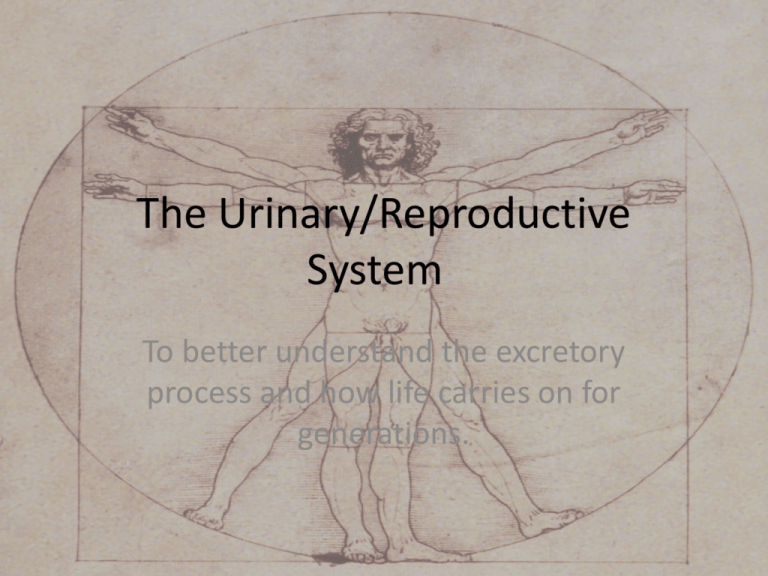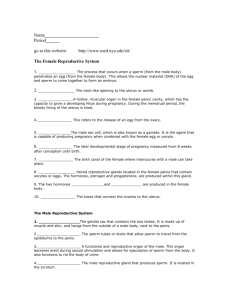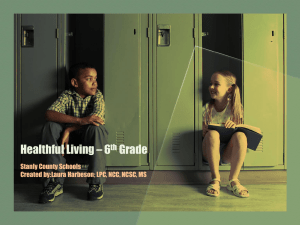Reproductive System
advertisement

The Urinary/Reproductive System To better understand the excretory process and how life carries on for generations. The Urinary System • The excretory system collects the wastes that cells produce and removes them from the body. • The system includes the kidneys, ureters, urinary bladder, and urethra. • The body MUST eliminate excess water and urea. Urea • Urea is a chemical that comes from the break down of proteins. • Urine includes urea, water, and other wastes. • Water-soluble vitamins (B and C) will also be excreted through the urine when your cells have received 100% of their Daily Value. The Kidney • The two kidneys are the major organs of the excretory (urinary) system. • The kidneys act as a filtering system that help to remove urea and other wastes from the blood, but keep materials that the body needs. The Kidney • Each kidney has about one million nephrons. • A nephron is a tiny filtering factory that removes wastes from blood and produces urine. Urine • Once the nephrons have filtered the blood, the wastes are moved through two tubes called, ureters, and urine is brought to the bladder. • The bladder helps to temporarily store the urine (collected, water-soluble waste) until it is excreted through the urethra. Homeostasis • The ability of an organism to keep internal conditions stable no matter what is happening in the external environment. (KEEP LEVELS IN BALANCE!) • Excretion helps to maintain homeostasis by keeping the body’s internal environment stable and free of harmful levels of chemicals. Reproductive System • The reproductive system allows for a process called fertilization to happen. • Fertilization requires the joining of an egg cell (female) and a sperm cell (male). • These sex cells are formed, along with hormones, by the ovaries and testes. Male Reproductive System • The male reproductive system is specialized to produce sperm cells and the hormone testosterone. • The structures include the testes, scrotum, and penis. The Testes • The male organ where sperm is produced. • In addition to sperm, the testes produce testosterone. • Testosterone controls the development of adult male characteristics, such as facial hair, deepening of the voice, broadening of the shoulders, and the ability to produce sperm. The Testes • The tests are located in a pouch of skin called the scrotum. • The scrotum holds the testes away from the rest of the body to keep them about 2-3 degrees Celsius cooler than the normal body temp. • Sperm cannot develop properly at 37 degrees Celsius (98.6 degrees F) Sperm • The male sex cell that is made up of a head and a tail. • The production of sperm cells begin when a male hits puberty, in the teenage years (1114). • The head contains genetic information such as blood type. • The tail allows the sperm to swim in fluid. Sperm • After forming in the testes, sperm travel through tubes and mix with fluid to make semen. • The fluids in semen provide an environment where sperm can swim and also contain nutrients that the sperm use for energy. • Semen leaves the body through the urethra, located within the penis. Urine and semen cannot leave the body at the same time. Female Reproductive System • The female reproductive system is specialized to produce eggs and nourish a developing baby until birth. • It also produces estrogen and other hormones. • The system is made up of the ovaries, uterus, fallopian tubes, vagina, and urethra. The Ovaries • The female reproductive structures that produce eggs. • The ovaries produce hormones such as, estrogen. • Estrogen triggers the development of adult female characteristics such as, the widening of the hips and the breasts to develop. • Estrogen is also involved in the development of eggs cells. Ovaries • One of the ovaries releases a mature egg into the nearest Fallopian tube each month. • Fertilization usually occurs in the Fallopian tube. • If the egg is not fertilized, the egg is released through the vagina. Menstrual Cycle • An egg develops and is released about once a month in a mature woman. • During the menstrual cycle, an egg develops in an ovary. At the same time, the lining of the uterus thickens in a way that prepares the uterus for a fertilized egg. • If the egg is not fertilized, it begins to break down. Puberty in Females • Timing of Puberty • Puberty starts at different times and lasts for different periods of time for everyone. It can start as early as 8 years of age to as late as 13 years of age. The sequence of puberty – from breast development to complete physical maturation – may take a year and a half or last as long as 6 years. Puberty in Females Puberty Event • Growth of breasts • Growth of pubic hair • Body Growth • First Period • Underarm Hair • Acne Ages at which it happens • 8-13 • 8-14 • 9 1/2 – 14 ½ • 10-16 ½ • 2 years after pubic hair shows up • Around the same time as under arm hair Puberty in males • Puberty can begin in males from the ages of 9-14, generally two years after females have already started the changing process • Hormones, ie testosterone, being produced in the testes, begin to be produced which start to cause changes in your body. Puberty in Males Puberty Event • Growth of testicles & scrotum • Growth of pubic hair • Body Growth • Growth of penis • Change in voice • Facial & Underarm Hair • Acne Age at which it happens • 10-13 ½ • 10-15 • 10 ½-16 ½ • 11-14 ½ • About the same time as penis growth • About 2 years after pubic hair appears. • About the same time as underarm hair appears.





